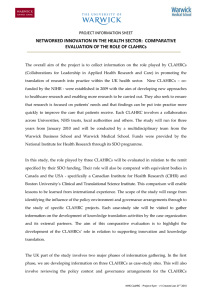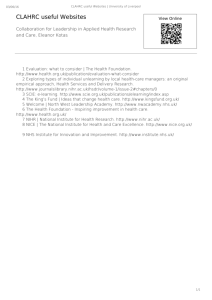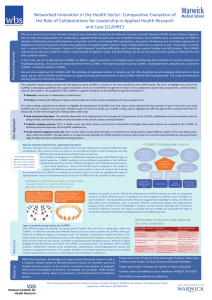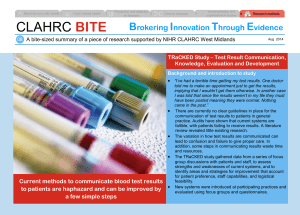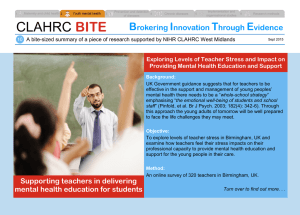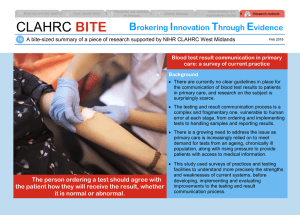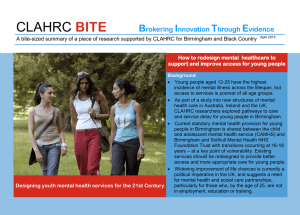Networked Innovation in the Health Sector (NIHS): Comparative
advertisement
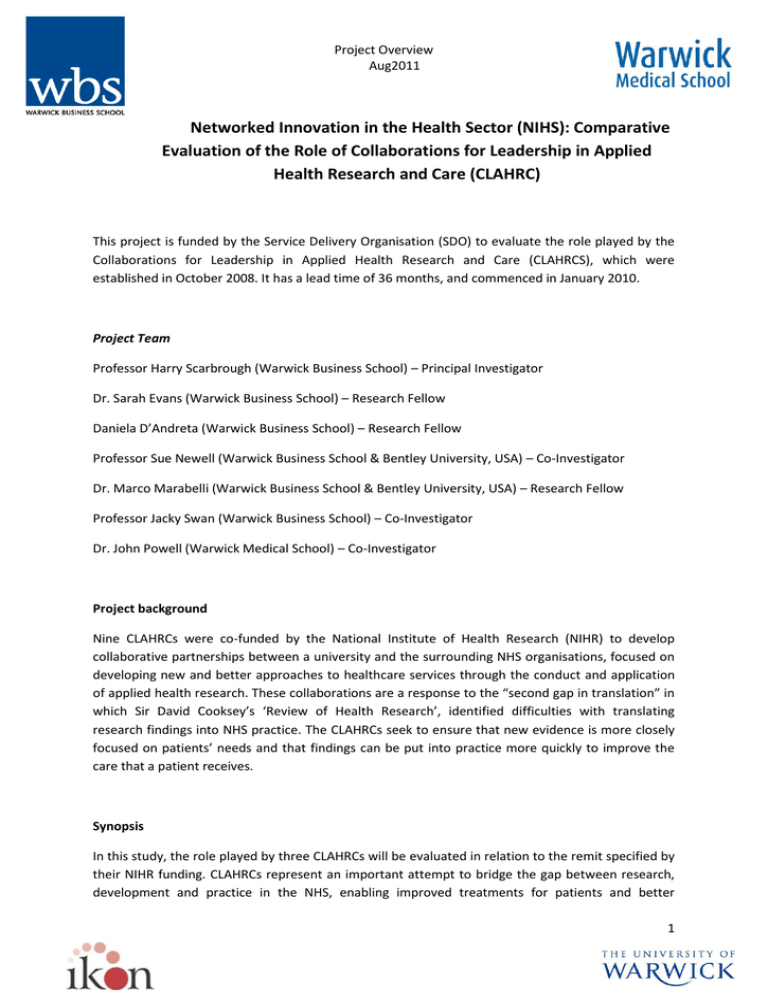
Project Overview Aug2011 Networked Innovation in the Health Sector (NIHS): Comparative Evaluation of the Role of Collaborations for Leadership in Applied Health Research and Care (CLAHRC) This project is funded by the Service Delivery Organisation (SDO) to evaluate the role played by the Collaborations for Leadership in Applied Health Research and Care (CLAHRCS), which were established in October 2008. It has a lead time of 36 months, and commenced in January 2010. Project Team Professor Harry Scarbrough (Warwick Business School) – Principal Investigator Dr. Sarah Evans (Warwick Business School) – Research Fellow Daniela D’Andreta (Warwick Business School) – Research Fellow Professor Sue Newell (Warwick Business School & Bentley University, USA) – Co-Investigator Dr. Marco Marabelli (Warwick Business School & Bentley University, USA) – Research Fellow Professor Jacky Swan (Warwick Business School) – Co-Investigator Dr. John Powell (Warwick Medical School) – Co-Investigator Project background Nine CLAHRCs were co-funded by the National Institute of Health Research (NIHR) to develop collaborative partnerships between a university and the surrounding NHS organisations, focused on developing new and better approaches to healthcare services through the conduct and application of applied health research. These collaborations are a response to the “second gap in translation” in which Sir David Cooksey’s ‘Review of Health Research’, identified difficulties with translating research findings into NHS practice. The CLAHRCs seek to ensure that new evidence is more closely focused on patients’ needs and that findings can be put into practice more quickly to improve the care that a patient receives. Synopsis In this study, the role played by three CLAHRCs will be evaluated in relation to the remit specified by their NIHR funding. CLAHRCs represent an important attempt to bridge the gap between research, development and practice in the NHS, enabling improved treatments for patients and better 1 Project Overview Aug2011 informed clinicians. The aim of this project is to examine how these new bodies are carrying out this role. It will do so by exploring their ability to build networks and to find new ways of translating the ideas of scientists into new ways of treating patients. Their role will also be compared with equivalent bodies in Canada and the USA engaged in applied and translational health research. This comparison will enable lessons to be learned from international experience. The scope of the study will range from identifying the influence of the policy environment and governance arrangements through to the study of the micro-level relationships formed within specific CLAHRC projects. This study is working with three of the CLAHRC collaborations: - Birmingham & Black Country CLAHRC (BBC) - Nottinghamshire, Derbyshire & Lincolnshire CLAHRC (NDL) - South Yorkshire CLAHRC (SY) In addition, we are working with three initiatives in North America - AHRQ-funded ACTION Networks, Boston, USA: These are collaborative networks between practitioners and academics that have been set-up in order to be able to bid-for, and undertake applied health research in policy areas identified by the AHRQ funding body. - Children’s Hospital of Eastern Ontario, Toronto Canada: This site is engaged in a collaborative initiative to implement evidence-based practices into a healthcare programme that involves multiple stakeholder groups. - St Mary’s Hospital & McGill University, Montreal, Canada: This is a programme of work aimed at bringing together academic expertise into a healthcare practice environment. Project aims The aim of this comparative evaluation is to highlight the development of the CLAHRCs’ role in relation to supporting innovation and knowledge translation. This will also include a comparison of the activities of UK CLAHRCs with equivalent bodies in the Canada and the USA, thus enabling lessons to be learned from international experience. Specifically, this project aims to: Identify the micro-level relationships which enable the translation of knowledge from research into practical settings. Map the evolving networks that underpin CLAHRCs, including the emergence of boundaryspanning groups and gatekeeper individuals, and brokering across ‘structural holes' between communities. Examine the impact of policy and governance arrangements within which such networks are situated on translations of knowledge between research and practice. Compare the UK CLAHRC initiative with initiatives in the US and Canada, recognizing their distinctive institutional contexts. 2 Project Overview Aug2011 Networked Innovation This project seeks to evaluate the CLAHRCs initiative through the lens of ‘networked innovation’. This perspective reflects the development of new collaborative, inter-organizational approaches to innovation. By emphasising the interplay between the innovation process, knowledge flows, and evolving social and organizational networks, this project is equipped to analyses and highlight the links (or lack or links) between the creation, diffusion and implementation of new research ideas and practices within these university & healthcare collaborations. By using this approach, this study will address the following questions: To what extent and how do CLAHRCs enable and promote networked innovation? How do the following influence the process of networked innovation by CLAHRCs? - National institutional context - Social and inter-organizational networks - Management and governance - Knowledge translation tools and processes What capabilities for networked innovation have been developed by the CLAHRCs? Overall, this study aims to: Provide an independent, and theory-based evaluation of CLAHRCs as a new form of networked innovation in the health sector. Support the organizational learning and improvement of CLAHRCs by providing comparative evidence and insights on their innovation capabilities within both a national and international context. Support improved patient outcomes by adding to the evidence base on networked innovation within the UK health sector, especially with respect to management and governance mechanisms. Make recommendations on improving the evaluation of knowledge translation through greater appreciation of the role of networks. Contribute to the international knowledge base on research use through cross-national comparisons, and the cross-fertilization of academic literatures. Data Collection This study is broadly divided into two major, partially overlapping phases of work which will allow better comparison of the development of CLAHRCs over time. Participants in the study include key members of the CLAHRC (including university staff, NHS staff and others) and the equivalent bodies in Canada and the USA. The study involves the gathering of information and views from a range of 3 Project Overview Aug2011 groups including the core CLAHRC management group, clinical and cross-cutting theme/ project team members and affiliated service providers, and managers & commissioners, but does not involve the gathering of information from or on NHS patients. Information for this study is being collected from participants through the following methods: Qualitative study of the CLAHRCs, including review of documentation and general organisation of the CLAHRC work and semi-structured interviews; This includes particular attention to how the CLAHRC work is being achieved in practice, through more detailed study of select number of project teams ‘micro-cases’ from each CLAHRC Social network mapping survey tool; through an online survey information about the ties that CLAHRC members use to collaborate with and depend upon in exchanging knowledge in order to be able to achieve their own role within the collaborative research initiative has been compiled. Cognitive mapping exercises; this is a simple tool to obtain and structure information on peoples' attitudes about the aims of the translational/ applied health research collaboration, and the components that are required to achieve this. Expected Outcomes & Benefits By comparing the activities of the three UK CLAHRCs, and contrasting this with the experience of the equivalent bodies in the USA and Canada, we will be able to gain a clearer picture of how well the CLAHRCs have developed the capabilities needed to carry out their role. We should also be able to provide feedback on the major factors influencing the development of these capabilities, and identify the lessons to be learned for the CLAHRCs themselves and for similar initiatives in the future. In the long run, by learning what works and what does not work in this kind of initiative the NHS will be better placed to improve the quality of care for its patients. The interim results of the study have already begun to be fed-back to the participating organisations in the form of tailored meetings and individual briefing-reports, so as to improve their practices and organisational learning. In addition, the results will be disseminated more widely through international, national and regional dissemination events, and in the form of interim and final reports to the SDO and NIHR. The results will also be incorporated in academic publications. 4
